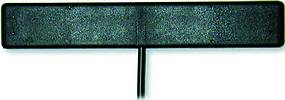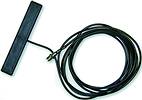900/1800 MHz cellular window-mount antenna
30 January 2002
Telecoms, Datacoms, Wireless, IoT

Poynting Antennas has recently launched a new antenna for use with cellular hands-free kits. This antenna was made using a novel manufacturing method patented by Poynting, allowing the company to reduce the cost of the antenna to US$ 3,75 for large quantities.
The dual band antenna is manufactured using the solder in plastic (SIP) technology unique to Poynting Antennas. It involves filling pre-moulded plastic cavities or tracks with solder, replacing metal stamping and/or PCB implementations. The advantages of this production technique are:
* Low cost of materials.
* Fast turn-around of high product volumes.
* Small number of assembly steps.
* High manufacturing reliability (good QA).
* Three dimensional structures can be manufactured.
The housing and radiator are combined into one product (the plastic housing into which solder is injected). The indentations or cavities within an enclosure provides the radiator and other electrical parts at negligible additional cost.
The GSM antenna covers the GSM, PCS, GSM1800, AMPS/CDMA/TDMA/PHS/ cellular bands. The antenna (115 x 20 x 4 mm) was designed to be attached on the window of a vehicle. The gain is 2 dBi and VSWR less than 2:1. It is supplied with 2,5 m of RG174 cable terminated in a FME female connector.
Poynting Antennas, situated in Wynberg, Johannesburg, supplies industry with electromagnetic engineering research and development services and products.
For further information contact Claire Nitch, Poynting Antennas, [email protected], www.poynting.co.za
Further reading:
What does Wi-Fi 7 mean for South African networks?
Telecoms, Datacoms, Wireless, IoT
With Wi-Fi 7 (802.11be), we are finally looking at a standard that was built, not just for more devices, but for the new way networks are used.
Read more...
Multiprotocol wireless SoC
RF Design
Telecoms, Datacoms, Wireless, IoT
The nRF54LM20A from Nordic Semiconductor is a multiprotocol wireless System-on-Chip designed for demanding designs in Bluetooth devices.
Read more...
High performance communication
iCorp Technologies
Telecoms, Datacoms, Wireless, IoT
Quectel’s FCS950R is a high-performance Wi-Fi 5 and Bluetooth 4.2 module that can deliver a maximum data rate up to 433,3 Mbps in 802.11ac mode.
Read more...
Expanded STM32WL3x line for IoT sensors
Altron Arrow
Telecoms, Datacoms, Wireless, IoT
The STM32WL31x and STM32WL30x are more tailored versions of the STM32WL33x for designers who wish to focus on specific features, while lowering their bill of materials.
Read more...
Full-band GNSS helical antenna
RF Design
Telecoms, Datacoms, Wireless, IoT
A key feature of Calian’s HC3990XF antenna design is that it does not require a ground plane, making it ideal for size-constrained applications.
Read more...
BLE and BT Mesh module
iCorp Technologies
Telecoms, Datacoms, Wireless, IoT
The HM-BT4531 from HOPERF is a BLE data transmission module that features an ARM Cortex-M0 32-bit processor.
Read more...
Espressif entering the Wi-Fi 6E market
iCorp Technologies
Telecoms, Datacoms, Wireless, IoT
Espressif Systems is entering the Wi-Fi 6E market, extending its connectivity portfolio into the domain of high-throughput, low-latency wireless solutions.
Read more...
Ultra-low jitter clock buffers
Altron Arrow
Telecoms, Datacoms, Wireless, IoT
New SKY53510/80/40 family of clock fanout buffers from Skyworks are purpose-built for data centres, wireless networks, and PCIe Gen 7 applications.
Read more...
Cutting-edge broadband power amplifier
RFiber Solutions
Telecoms, Datacoms, Wireless, IoT
Designed for high efficiency and reliability, the WPGM0206012M from WAVEPIA is a cutting-edge broadband GaN MMIC power amplifier operating from 500 MHz to 8,5 GHz.
Read more...
The trends driving uptake of IoT Platform as a Service
Trinity IoT
Editor's Choice Telecoms, Datacoms, Wireless, IoT
IoT platforms, delivered as a service, are the key that will enable enterprises to leverage a number of growing trends within the IT space, and access a range of benefits that will help them grow their businesses.
Read more...



